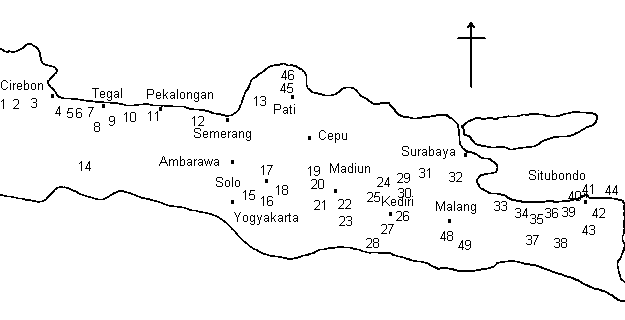|
2000 saw my 20th visit to Java and I led my 12th tour. Despite my pessimism, everyone
agreed that there was still more than enough activity to satisfy the first time visitor
and I was back again in 2001. You can read my analysis of the
prospects for the season.
This is the 2000 report, Click here for a brief summary of the main news,
other reports are available:
Click here for the Mill Index or Mill Map or choose the area you want:
The mills are arranged from West to East, North Coast
then South Coast with the Private Mills at the end. Click on the mill in the Index below
(mills with no link have not used steam in recent years, but may have locos stored on
site):

The numbers are those used in the reports.
The Main News in Brief
Contents
- Kadhipaten in West Java is not milling this year and from experience unlikely to
re-open. Tersana Baru, Ketanggungan Barat and Sindanglaut were working normally.
- Further along the north coast, Jatibarang,
Pangka, Sumberharjo and Sragi were working
much as in 1999.
- Tasik Madu was working normally by mid-July.
- Madiun mills were no worse than 1999, but short of closure it would be difficult to
decline further.
- Merican, Pesantren, Mojopanggung, Ngadirejo and Gempolkerep were milling normally.
- De Maas did not mill this year and its future is very much in doubt. Olean, Asembagus
and Wringinanom were working much as in 1999. The only regular steam at Semboro was the
firelesses.
- Pakis Baru briefly refined raw sugar and did not use its railway, but Trangkil was
working normally.
- Kebonagung has closed its eastern field lines.... Disaster!
Prospects for 2001
Contents
I wrote this in September 2000. How good were the predictions? Read the 2001 report.
- The long term prospects for the sugar industry (and its remaining steam locomotives) are
very poor. A few large (and relatively efficient) mills will survive, but what is left of
their railways will almost inevitably be dieselised. The only question is one of timing.
Since the end of the 1997 season, nine sugar mills have ceased operation and, equally
important, (steam) field operations have been abandoned at two more. In August 2000, the
English language Jakarta Post reported that four more mills (unnamed) would close at the
end of the season. The Government has stated its intention to close no less than a
further 22 of the 57 mills in due course.
- The short term prospects for the industry are tied to the
Rupiah/US $ exchange rate. In
1997, U$1 bought Rp 2500. Within a year it was more than Rp 10000, before dropping back to
around Rp 7000 in 1999. By mid-2000, the underlying value was about Rp 8000 although
political uncertainties caused it to fluctuate wildly. Sugar imports have been
liberalised over the last year and the local sugar price broadly reflects world prices.
- The 2000 season was much better in terms of cane quantity and quality than 1999, the
slight devaluation of the Rupiah has helped push up prices. There was no repetition of the
early (mid-August) shut downs seen then. However, labour shortages have again been evident
in some areas which confirms that the Javanese economy is recovering strongly. Few people
want to cut cane for around U$2.50 a day or less and much cane is now 'ratooned' (= grow
again in the same place as opposed to making part of a rice/sugar cycle).
- The Government would like to close more mills, but the (Government owned) sugar
corporations are naturally opposing this, not least on the grounds of the social upheaval
it would cause in some areas (especially around Situbondo).
- Several of the individual mills are being more proactive in ensuring cane supplies by
direct leasing of land, plenty of cane has been planted for next year and I believe that
there will be sufficient steam activity in 2001 to make visits worthwhile. Anyone who
visited Java in the early or mid-90s would naturally find the scene disappointing, but I
think that (as in 2000) a first time visitor will be more than satisfied at seeing between
50 and 100 narrow gauge steam locomotives still working.
- Add in the possibilities of special trains at Ambarawa and
Cepu, together with visits to
the sugar mills themselves with their ancient steam powered machinery and you can have a
steam trip which has no equal in the world today. I plan to try to run two tours, one will
be the conventional 'all-steam' tour, the other (for the first time) will combine the best
of steam with visits to Java's conventional tourist attractions - the volcanoes,
antiquities and cultural centres. Please Email me
for details.
PT Keretapi News Contents
I booked no less than 4 specials at Ambarawa on July 21st/22nd and August 10th/11th
2000. These used B25 and E10 as usual.
These are pictures of our 2000 specials.




Cepu Forest Railway Contents
Regular logging trains have now ceased altogether and much of the system has been
lifted. The only way to see this unique operation is to organise your own special logging
trains which I booked on July 26th and August 7th 2000. The little DuCroo and Brauns
0-6-0T, made it all the way to the forest along with the normal Berliner 0-10-0T on both
days. However, the political anarchy which is taking over the country has seen large parts
of the forest devastated. They are planting on an 80 year cycle but cutting on a 10 year
cycle....


Check out the 2002 Cepu pictures.
|
|






